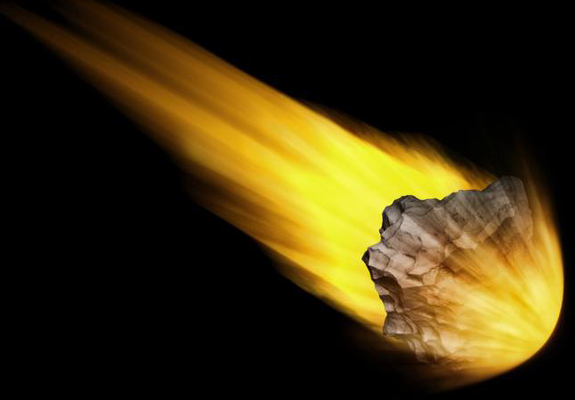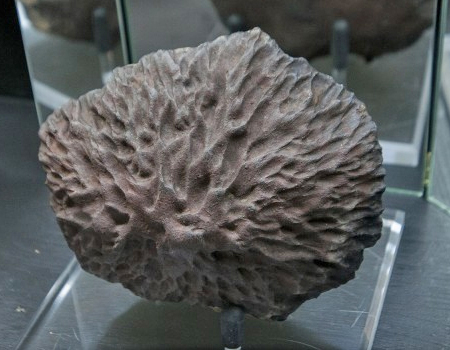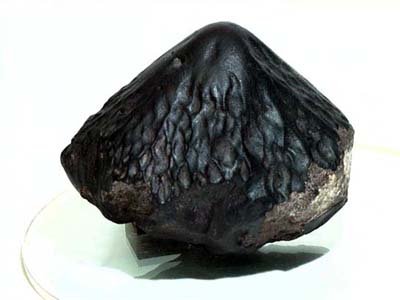Orientation and Oriented Meteorites

A meteoriteWork in progress. A solid natural object reaching a planet’s surface from interplanetary space. Solid portion of a meteoroid that survives its fall to Earth, or some other body. Meteorites are classified as stony meteorites, iron meteorites, and stony-iron meteorites. These groups are further divided according to their mineralogy and Click on Term to Read More develops orientation when it experiences a period of stable flight through Earth’s atmosphere and is gradually further ablated into an increasingly more stable and aerodynamic shape (cone or shield). The resulting meteorite can show evidence of flow lines, roll-over lipping and regmaglypts. Though features of orientation can be seen on any meteorite type, iron meteorites (e.g Sikhote Alin) best preserve the faintest and most distinct features that the meteorHow long Sonic booms Of the several 10s of tons of cosmic material entering Earth's atmosphere each day, only about one ton reaches the surface. An object's chance of survival depends on its initial mass, speed and angle of entry, and friability (tendency to break up). Micrometeoroids radiate heat so Click on Term to Read More experienced as it smashed through our atmosphere.

As meteors rarely develop into perfect stable cones and can still experience significant ablationGradual removal of the successive surface layers of a material through various processes. • The gradual removal and loss of meteoritic material by heating and vaporization as the meteoroid experiences frictional melting during its passage through the atmosphere. The resulting plasma ablates the meteor and, in cases where a meteor Click on Term to Read More during inversion, tumbling, and gliding trajectories, the characteristics associated with meteorite orientation can appear somewhat subjective for the uninitiated. However, there are clear objective identifying characteristics associated with oriented meteorites that make them prized by collectors. One or more of the features listed below can be found on all oriented meteorites:
- Conical or shield shape where the leading surface or apex experiences the highest temperature and pressure and is ablated into a rounded shape, and the trailing surface is more or less flat (can be slightly concave, convex or a combination of both).
- Flow lines indicating a consistent direction of travel and, emanating from the apex of meteorite and leading back towards trailing surface, or flowlines can also occur in certain areas below the leading surface. The most dramatic flowlines occur in a radial pattern as seen below on the Lafayette meteorite.
- Roll-over rim/lip develops when the ablating/melting material begins to flow over onto the back side of a meteor or from a protuberance on the leading surface. The material that has lipped over can also have flow lines and even appear frothy with tiny bubbles in the lipped region. Some meteorites can even experience double lipping indicating that they experienced stable flight in two directions.
- Regmaglypts or fluting/feathering (long regmaglypts) indicating large scale ablation in a consistent direction radiating from the apex. In rare cases, the regmaglypts can occur in a radial pattern as well.
- Spattering of small molten droplets (called travelers by some collectors) that adhered on the meteorite’s trailing surface or behind a feature like a raised surface or protuberance. This feature is typically seen on iron meteorites though large droplets have been seen on the backside of oriented stony meteorites. Evidence of this feature does not by itself mean the meteorite is oriented, though it can be associated with it.
A word of caution: Meteorites that don’t display flowlines (2), lipping (3), or regmaglypts (4) can be mislabeled as oriented. Just because a meteorite is shaped like a pyramid or sits on a flat edge does not mean it is oriented. Some meteorites are clearly oriented, but if there are doubts, ask an expert.




Note that rotational spin plays an important role in the shaping and stability of a meteor but is not discussed in detail here. Also, the plasticity of tektites during flight leads to amazing orientation effects as seen in AustraliteTektites found in Australia and are part of the Australasian Tektite Field, a region extending as far as Sri Lanka to the West, Tasmania Australia to the South, Philippines to the East and Southern China to the North. Australites were deposited 0.79 Ma ago by a massive impact that rained Click on Term to Read More flanged buttons.






